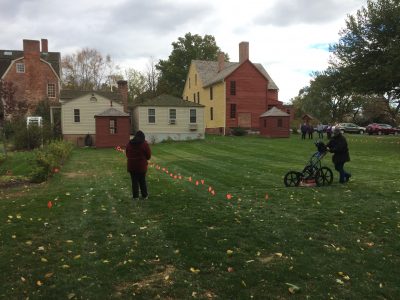GPR at Webb-Dean-Stevens

Spring 2017 News From the Office of State Archaeology
It has been a time of change here on campus for the Connecticut State Museum of Natural History. Many of you may have heard that the museum lost the exhibit and office space it has held for the past decade. Officially, staff has been shifted from the College of Liberal Arts and Science to the Office of Public Engagement, yet the museum maintains a strong degree of autonomy since state statutes very wisely provide direct oversight by the museum’s board of directors, rather than a single university division. Nonetheless, it has been a time of significant challenges for director Leanne Harty, program coordinator David Colberg, exhibit developer Colin Harty and myself. One of the positive things to come from the move is a recently drafted strategic plan written to guide museum priorities over its next three years. One of those priorities is the return of permanent exhibit space, since without it, we are ineligible for many federal funding opportunities. Coordination with Public Engagement also has the potential to provide a new impetus for programming and outreach activities, and I am currently developing a number of potential project ideas for the coming summer. For those looking for me, I am temporarily housed with Math Department faculty in Monteith 408.
I just made a list of over twenty important activities that occurred last fall and early winter, but I’ll stick to a summary of just a few. First, I’d like to thank FOSA President Mandy Ranslow, and members Nick Bellantoni and Gary Nolf for their help running four hands-on programs for kids held at Wood Memorial Library and Museum in South Windsor. OSA now has a thoughtfully packed box of educational materials that make programs like this focused on Native American and Colonial archaeology and history fun for young audiences. Hopefully we’ll further develop our core of educational volunteers for future programming opportunities.
FOSA members also had a chance to participate in Ruth Shapleigh-Brown’s and Debbie Surabian’s GPR survey demonstration at the Old Hebron Cemetery. Afterwards, a number of volunteers went on to help with some additional radar work at the Webb-Deane-Stevens House in Old Wethersfield. That work identified a number of large buried features, and I’m looking forward to hearing what they turn out to be (hopefully at least one buried cellar!) when AHS, Inc. gets back to investigate them this Spring.
Of course, October fifteenth was International Archaeology Day and this year we celebrated with the Connecticut Archaeology Fair at UConn, Storrs. Participation was great, with lots of booths, demonstrations and activities for kids, so my thanks go to all who helped to coordinate the event. Special thanks go to FOSA’s Mandy Ranslow and UConn Department of Anthropology’s Daniel Adler. Dan, in particular, managed to rustle up a lot of student support that made the day possible. FOSA’s own booth included a new book sale made up of material culled from the OSA library. These books were made available primarily because they were not directly associated with regional archaeology. Visitor’s purchased a number of interesting books with all funds donated to FOSA. The meeting also hosted the Archaeology Society of Connecticut’s fall meeting and included a variety of excellent talks, including one by Zac Singer summarizing last summer’s important work at the Templeton Paleoindian Site that many FOSA members helped with.
In the meantime, FOSA volunteers have been busy prepping and inventorying artifacts from the David Humphreys site (Ansonia) and I am pleased to say Scott Brady and Lee West just completed the data entry work on that interesting assemblage. FOSA volunteers also had a chance to organize a large donated collection from Nicholas Kotula. Nicholas’s artifacts came from a variety of sites across New England, New York and Pennsylvania. We have most recently been focused on organizing finds from the 1990 and 1991 UConn field schools at the Oliver Ellsworth House in Windsor because I have hopes of doing follow-up work there this summer. So, volunteers will still have plenty of opportunities to help this Spring in the lab. On campus, inventory work on the Lt. John Hollister site has progressed rapidly as well with the help of my research assistant Megan Willison and five undergraduate interns.
To wrap up, I just want to add how excited I am to have Emerson (Tad) Baker coming to speak to us on March 25 at Farmington High School. Tad has excavated a number of very significant 17th century settlement period sites in southern Maine, and is arguably New England’s expert on the material culture and architecture of this poorly documented period. Having him visit will provide an important opportunity to show him our own artifacts from the Lt. John Hollister site and discuss the potential architectural layout of that site based on the results of two season of radar examination. In that vein, be sure to sign up for the Connecticut State Museum of Natural History’s upcoming day trip to Plimoth Plantation scheduled for April 15th. I plan to use part of our time on the bus to discuss our recent finds at the Lt. John Hollister site as well as other important 17th Century topics.